|
 |
|
| Dick Contino (17 January 1930 – 19 April 2017) |
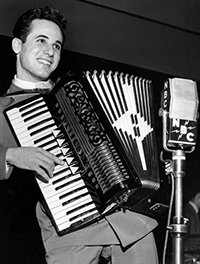 AWAM proudly announces the impending arrival of Dick Contino’s estate as a major landmark event for our museum. This 1940s idol and national heartthrob prompted unparalleled accordion enthusiasm that inspired thousands of aspirants and greatly promoted the industry in general. AWAM proudly announces the impending arrival of Dick Contino’s estate as a major landmark event for our museum. This 1940s idol and national heartthrob prompted unparalleled accordion enthusiasm that inspired thousands of aspirants and greatly promoted the industry in general.
Contino won the hearts of American audiences after winning Horace Heidt’s talent contest with his version of “Lady of Spain.” Thereafter featured on major television shows, his public performances drew extraordinary audience numbers and unprecedented income. His name became, and remains, one of the most prominent in American accordion history.
His brilliant virtuosity and charismatic stage presence regularly thrilled Las Vegas audiences even into his advanced years. Contino died in 2017 at age 87.
Mrs. Judy Contino, in current phone calls, declared her intention to donate a significant portion of her husband’s estate in order to draw ongoing public attention to the legacy of his contributions to American culture. In addition, for our 2020 World Accordion Day festival she committed to presenting a 45-min. talk to include unpublished excerpts of Dick’s life, some with humorous anecdotes that portray the real person who was more than a world celebrity.
The announced donations include recordings, photos, music in published and manuscript form, and sundry items of varied import. One of these will be a life-size mannequin accompanied by some performance clothes worn in his Las Vegas shows. This figure will be displayed in our Special Exhibits Area as a new focal attraction of the Concert Hall.
It is particularly interesting to note that during our 2019 festival, Bill Palmer, III, incidentally related the story of how Contino urged his father to construct what became the Palmer-Hughes Accordion Method. He will retell the anecdote as a tie connecting World Accordion Day (May 2) and our Eighth Annual Dr. Willard Palmer Festival (May 3). Additional connections between the two upcoming events will involve musical titles that Contino made household favorites, played by the ACM Band and soloists including Dr. Michael Middleton.
Much has been written about Dick as an American idol: “He was promoted as the ‘Rudolph Valentino’ of the accordion…With muscled arms built up with barbells and Charles Atlas’s dynamic tension exercises, Mr. Contino played the accordion like a rock star. His fingers flew over the keys. Elvis-like, he wiggled, shook and swaggered. He played polkas, jazz, romantic songs, show tunes and folk music. And, of course, Lady of Spain.” |
| Charles Magnante (7 December 1905 - 30 December 1986) |
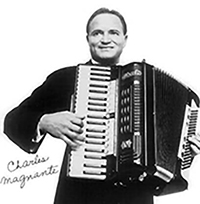
Charles Magnante (1905–1986) was an American piano-accordionist, arranger, composer, author and educator. His artistry helped raise the image of the accordion from an instrument considered suitable only for folk music to an instrument accepted in many music genres.
Charles Magnante was born in New York City on 106th Street in an area known as Harlem. From very humble roots his unique career placed him on the pinnacle of accordion history. No one has ever equaled his success as the ultimate world accordion artist.
Throughout his long and fantastic career, Magnante has consistently been considered by many to be the most finished accordionist of all time. He was famous for many years as a top radio, television star and recording artist. He was associated with some of the worlds finest conductors and orchestra leaders performing either as a soloist or a member of the orchestra.
It could be said that Magnante's musical career began at the age of five when he sand along with his Dad, a popular amateur accordionist, who used to play for many Italian weddings. At the age of seven, he was stealing his father's prized accordion from the closet and teaching himself to play by ear. At sixteen he was turning down many offers to tour professionally as he felt traveling would take up time which should be spent in continuing his studies.
During the peak of his career he reached the point where he was doing as many as thirty one radio broadcasts and an average of about eight recording dates in a single week. His audiences ranged from small intimate groups to packed auditoriums of three thousand. One of his greatest thrills was at the Civic Stadium in Buffalo, NY when he played for an audience of over forty thousand people.
One of Magnante's best known compositions is the novelty solo "Accordiana" which he composed in exactly twenty minutes. His textbooks, arrangements, and original compositions are numbered by the hundreds and include popular, classical, jazz, and boogie-woogie.
As an outlet from his strenuous career in music, Magnante engaged in the sport of big game hunting as much as possible. He had taken over fifty head of big game and was a member of the exclusive Campfire Club of America which is located in Braircliff Manor, about thirty five miles from New York City. His hunting expeditions in the US, Canada and Mexico brought him trophies of antelope, deer sheep, moose, caribou and grizzly bear along with numerous other species. His prize mount was a one thousand pound grizzly and many of his hunting experiences were featured articles in a number of sports magazines.
Magnante's life is the story of a man who overcame seemingly insurmountable obstacles to achieve success in his chosen field and become a legend in his own lifetime. He passed away on Dec. 30, 1986 having given the world a legacy of accordion achievements unlikely to be equalled by anyone in the discernible future. |
| Pietro Deiro (1888 – 1954) |
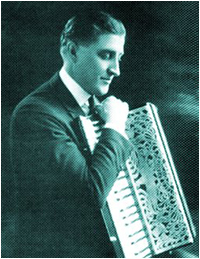
Pietro Deiro was one of the most influential accordionists of the first half of the 20th century.
Born in Salto Canavese, Italy, the younger brother of Guido Deiro, he emigrated to the United States in 1907 to live with his Uncle Frederico and work in the coal mines of Cle Elum, Washington.
Pietro began playing Diatonic button accordion professionally in a tavern in Seattle in 1908. Within a few short months, his brother Guido (already an accomplished piano-accordionist in Europe) arrived in Seattle, and taught his brother how to play the piano accordion. Both brothers became minor celebrities on the vaudeville circuit; Guido in 1910 and Pietro at least by 1912.
Pietro recorded dozens of records for the Victor Talking Machine Company. After the demise of vaudeville during the Great Depression, he opened a successful accordion studio in Greenwich Village, New York City and established an accordion music publishing company: Accordion Music Publishing Company (AMPCO), later simply known as Pietro Deiro Publications.
He was the first president of the American Accordionists Association (1938) and promoted himself as "The Daddy of the Accordion," much to his brother Guido's chagrin. Pietro died in 1954.
|
| Sylvia Prior (14 March 1922 - 9 August 2013) |
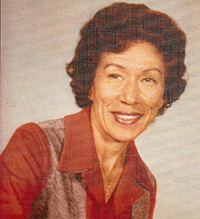 Sylvia Prior was born in Los Angeles, California on to Sylvester Louis Prior and Mary Louise Landon Prior. She passed away peacefully on August 9, 2013 in Ventura, California. Sylvia taught accordion and piano in Los Angeles and later in Oxnard for nearly 60 years, carrying on the business her father started in 1917. She loved teaching music and took great pride in knowing that she had touched the lives of countless students during her career. Sylvia Prior was born in Los Angeles, California on to Sylvester Louis Prior and Mary Louise Landon Prior. She passed away peacefully on August 9, 2013 in Ventura, California. Sylvia taught accordion and piano in Los Angeles and later in Oxnard for nearly 60 years, carrying on the business her father started in 1917. She loved teaching music and took great pride in knowing that she had touched the lives of countless students during her career.
The most important thing in Sylvia's life, however, was her family, especially her two daughters. Sylvia was a devoted mother who taught by example the importance of kindness, generosity and compassion. She was one of a kind and will be greatly missed by her family and friends.
Sylvia is survived by her daughters Adrian Jo Guidotti (David Ross) and Sylvana Louise Guidotti, M.D. (Kevin Wells), as well as her sister Patricia Kessen (Willard) and her nephew Jeffery Kessen. She is also survived by many devoted friends and her faithful dogs Gina and Scout. Sylvia was predeceased by her big sister Dorothymae Nelsen, husbands Tito Guidotti and Richard Westhouse, and her niece and goddaughter Dorothy Lee Pabst. |
| Hugo Herrmann
(19 April 1896 - 7 September 1967) |
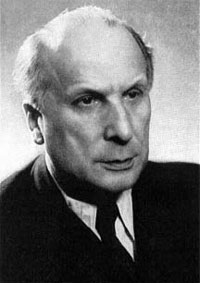 Hugo Herrmann was a renowned composer, conductor, organist and accordionist. His first instrument was the organ, however in addition to this, he also studied piano, composition and conducting at "Hochschule für Musik" in Berlin. During a stay in the USA, he served as a conductor, concert musician, organist and church choir conductor in Detroit from 1923 to 1925.
Hugo Herrmann was a renowned composer, conductor, organist and accordionist. His first instrument was the organ, however in addition to this, he also studied piano, composition and conducting at "Hochschule für Musik" in Berlin. During a stay in the USA, he served as a conductor, concert musician, organist and church choir conductor in Detroit from 1923 to 1925.
He wrote more than 90 compositions in various instrumentations, and served as the headmaster of "Trossinger Harmonika-Fachschule" (later "Städtische Musikschule Trossingen") from 1935 to 1963.
He was appointed professor in Trossingen in 1950 and during his lifetime he wrote compositions for various genres, especially choral music and many works for accordion orchestra. Unfortunately, he lost many of his compositions during World War II. Numerous of his works are housed at the AWAM.
|
| Willard A. Palmer (31 January 1917 - 30 April 1996) |
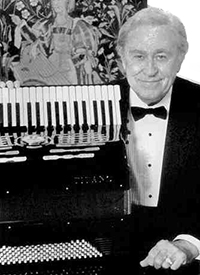 The name of “Bill” Palmer is certainly the USA’s most influential in music pedagogy, critical editions, and performance. The name of “Bill” Palmer is certainly the USA’s most influential in music pedagogy, critical editions, and performance.
The American musician, composer, scholar and music educator, Willard (Bill) A. Palmer was a child prodigy. At 13, he played the piano on the radio. He studied both piano and accordion which were to form the basis of his musical endeavors.
After the war, Willard A. Palmer and his former student, Bill Hughes joined forces. They can be credited with the high point in accordion performance in the USA. Palmer collaborated with Hughes in producing a series of accordion method books which have had world wide impact. Sales ran into the millions making it the cornerstone of the Alfred Publishing Co. empire.
As an educator, Willard A. Palmer was ahead of his time - instrumental in carving an indisputable niche for the accordion at the university level. He and Hughes took the accordion beyond mere college acceptance, into the realm of establishing an actual accordion department within the University of Houston, where they were faculty members enabling young accordionists to earn both Bachelor's and Master's degrees with their instrument. Palmer also founded the "Palmer-Hughes Accordion Symphony", a superb orchestra which appeared at Carnegie Hall in New York.
During his period as a professional accordionist, Willard A. Palmer sought to perfect his yet-evolving instrument and contributed significantly to the development of the stradella-free bass "convertor" accordion. He designed the "Palmer Emperor Convertor", and collaborated with Titano Accordions to achieve the realization of his creative ideas.
Willard W. Palmer eventually became one of the most important editors of keyboard music in the United States. His editions of works of the masters are highly acclaimed and respected in the most elite music circles. Palmer is noted especially for his painstaking detail and care in the scholarly researching of original editions. He became Alfred Publishing Company's Senior Editor in 1964, researching the original manuscripts of the great masters of keyboard literature, with special emphasis on the study of performance practices in the Baroque, Classic and Romantic eras. He achieved recognition as the leading authority on Baroque ornamentation and lectured on the subject at various colleges, universities and music festivals throughout the country.
While achieving accolades for his educational works for other instruments, Willard W. Palmer remained a steadfast supporter of his beloved accordion.
Willard A. Palmer's revolutionary teaching principles were reflected in 789 of his published works, which included an accordion method, several piano methods, a method for Hammond Chord Organ, a guitar method, hundreds of solo pieces and many choral works.
In 2013 his son, Willard Palmer, III, donated his father’s musical estate that includes one of the finest accordions of the museum (Titano Super Emperor V, 1996) and the decorous two-manual, eleven-pedal harpsichord (A. Cecil Taylor, 1979) that graces the concert hall. |
| |
|